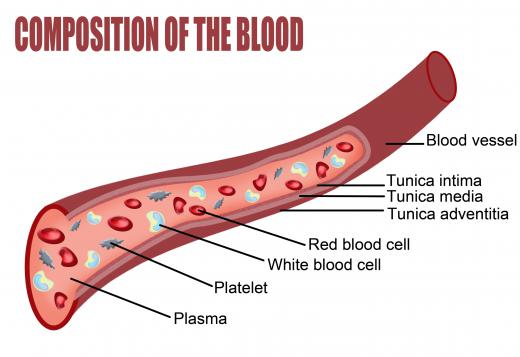What is a Platelet Factor?
Platelet factors are a group of small proteins that are released to help promote blood coagulation and clotting. They send a biological signal that tells the platelets in the blood to form clots. Platelets, which are also called thrombocytes, are small cells that are a component of the blood. The function of platelets is to form blood clots after wounding, and the number of platelets in the bloodstream helps control how easily blood clots form.
Platelet factors are needed to help form a scab over a wound and promote wound healing. Blood is constantly moving through the blood vessels, and when it comes across a broken vessel in a wound, the platelets begin to release platelet factors. These then signal to neighboring platelets as they flow in the blood towards the wound, telling them to aggregate and form clots. Clotting cuts off the bloodstream at the site of the wound and stops the bleeding. Once a clot is formed, the body can begin to heal the wound.

There are different types of platelet factors in the body, and they work together in different ways to promote blood clotting. The most characterized of these are Platelet Factor 3 and 4, designated PF-3 and PF-4, respectively. PF-3 is involved in the activation of clotting factors in the blood, whereas PF-4 is involved in turning off anti-clotting factors to facilitate clotting.

Many diseases involve problems with the number of platelets in the blood and the amount of platelet factor that is present. Too much platelet factor protein can lead to the formation of harmful clots that can block blood vessels, called thrombophilia. If there is too little platelet factor in the blood, the ability to form clots to close a wound will be decreased, called hemophilia.

When there is too much platelet factor protein present, the body responds by forming clots in the absence of wounding. This can be a serious problem, as blood clots within vessels in the brain can cause a stroke, and blood clots in vessels can lead to heart disease and heart attacks. Often, people who have suffered from strokes and heart disease may be prescribed blood thinners, such as heparin. These drugs partially counteract the normal function of platelet factors and prevent future incidents. People at risk for clotting disorders need to monitor both the number of platelets in their blood, and the amount of platelet factor present.

Increased amounts of platelet factor can lead to the development of other diseases, even those that are not direct clotting diseases. A study found that patients suffering from Crohn’s Disease had increased amounts of certain platelet factors in their bloodstream, and similar results were found in patients suffering from ulcerative colitis and irritable bowel disease. For anyone who has a family history of these disorders, routine platelet factor checks may be an early indicator of a problem, which can then prevent future disease.
AS FEATURED ON:
AS FEATURED ON:
















Discuss this Article
Post your comments